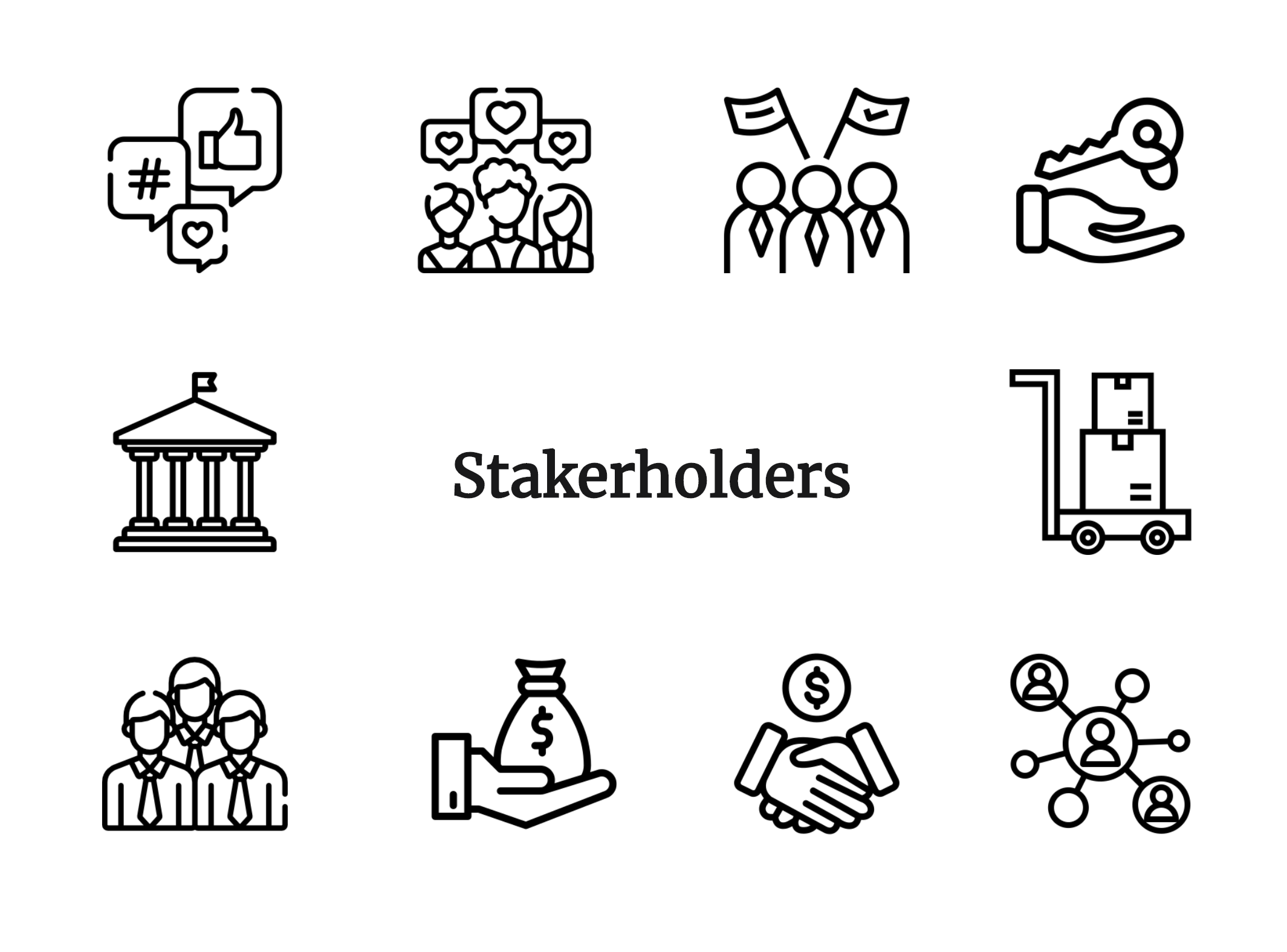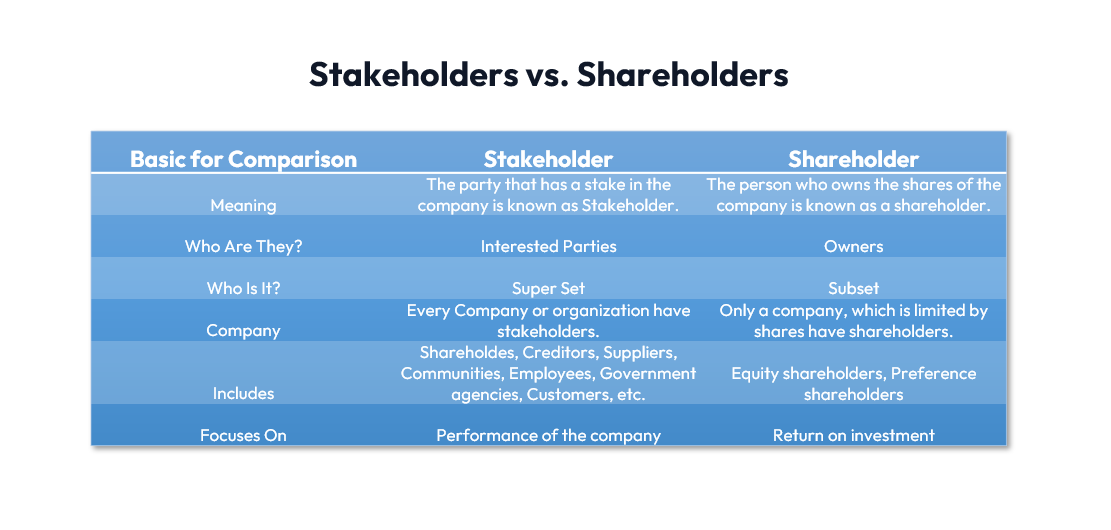In the ever-evolving realm of business, it's critical to know who holds sway in your organization. These influencers are stakeholders, entities that have a vested interest in the success or failure of your company. Understanding the different types of stakeholders and their potential impact on your business decisions can be the key to your company's prosperity. So, let's delve into the intriguing world of stakeholders and shed light on their unique roles.
What is a Stakeholder?
At the most basic level, a stakeholder refers to an individual, group, or organization that has a stake in the outcome of a business' activities. They stand to gain or lose from the company's policies, objectives, and actions. The idea behind the stakeholder concept is that many entities beyond the company's shareholders may affect or be affected by a company's actions.

What Types of Stakeholders Are There?
A successful business thrives on relationships, and these connections involve a variety of individuals, groups, or entities known as stakeholders. The term 'stakeholder' might seem straightforward, but under the surface lies a broad classification that provides a deeper understanding of who these stakeholders really are.
Stakeholders are classified based on their relationship with the business, their level of influence, and the degree of impact they can wield on the company's operations. This categorization helps companies map out their stakeholder landscape, prioritize them, and develop strategies to engage effectively with each group. Let's delve deeper into these three major classifications:
- Internal or External- Stakeholders can either be part of your organization's workforce or exist outside it. Internal stakeholders include employees, managers, board members – basically, anyone on your payroll. Their contributions directly affect the daily operations and overall health of your company. External stakeholders, on the other hand, do not directly contribute to your business operations but play an essential role nonetheless. They include suppliers who provide necessary materials for your business, customers who purchase your products or services, and investors and creditors who finance your operations.
- Primary or Secondary- The relationship a stakeholder has with your business also determines their classification. Primary stakeholders have a direct interest in your company’s success or failure. This group includes employees who want job security, customers who demand value for their money, and investors who expect a return on their investment. Secondary stakeholders, on the other hand, may not interact with your company regularly but could still affect or be affected by your actions. These include local communities impacted by your company's activities, the media that cover your business, and government agencies that enforce regulations.
- Direct or Indirect- This category highlights the stakeholder’s degree of influence over your company's decisions and actions. Direct stakeholders have a strong influence on your business – think owners, shareholders, employees. Their actions and decisions have immediate and visible effects on your company's outcomes. Conversely, indirect stakeholders do not have a direct hand in your operations but can still wield influence. For instance, industry regulatory bodies may affect how you conduct your business without being directly involved in your day-to-day operations.
The 10 Different Types of Stakeholders
Unraveling the dynamics of a business requires understanding the distinct roles of its key players. Here's an in-depth look at the ten different types of stakeholders that play critical roles in any business:
1. Suppliers
These are businesses or individuals providing your company with goods or services essential for your operations. Maintaining a healthy relationship with suppliers is crucial to ensure the uninterrupted flow of vital resources for smooth operation.
Is a supplier…
- An internal or external stakeholder?
- A primary or secondary stakeholder?
- A direct or indirect stakeholder?
2. Owners
Whether it's a single proprietor or a group of partners, owners have significant financial and strategic interest in the company. They look for profitability and growth, underlining their roles in steering the organization's direction.
Is an owner…
- An internal or external stakeholder?
- A primary or secondary stakeholder?
- A direct or indirect stakeholder?
3. Investors
These are individuals or entities who inject capital into your business expecting a return on investment. They have a vested interest in your company’s financial performance, influencing decisions that enhance profitability.
Is an investor…
- An internal or external stakeholder?
- A primary or secondary stakeholder?
- A direct or indirect stakeholder?
4. Creditors
Creditors lend money or extend credit to your business. Their primary interest lies in the timely repayment of these loans with interest. Companies need to manage this relationship diligently to maintain a positive credit rating.
Is a creditor…
- An internal or external stakeholder?
- A primary or secondary stakeholder?
- A direct or indirect stakeholder?
5. Communities
The local communities surrounding your business operations can be significantly impacted by your activities. Their interests lie in corporate responsibility, employment opportunities, and the overall economic growth of their locality.
Is a community…
- An internal or external stakeholder?
- A primary or secondary stakeholder?
- A direct or indirect stakeholder?
6. Trade Unions
Trade unions represent the collective interests of your employees. They negotiate for better working conditions, fair pay, and job security. Their impact on labor relations and employee satisfaction cannot be understated.
Is a trade union…
- An Internal or external stakeholder?
- A primary or secondary stakeholder?
- A direct or indirect stakeholder?
7. Employees
They are the backbone of your company, driving its day-to-day operations. Their interests center on job security, fair treatment, and proper remuneration. Engaged employees can be significant drivers of productivity and growth.
Is an employee…
- An internal or external stakeholder?
- A primary or secondary stakeholder?
- A direct or indirect stakeholder?
8. Government Agencies
These regulatory bodies ensure businesses adhere to laws and regulations. They aim for compliance and can influence your business through policy-making and enforcement.
Is a government agency…
- An internal or external stakeholder?
- A primary or secondary stakeholder?
- A direct or indirect stakeholder?
9. Customers
Your business exists to meet the needs of customers. Their interests revolve around receiving quality products or services at a fair price. A satisfied customer can significantly impact your company's reputation and profitability.
Are customers…
- An internal or external stakeholder?
- A primary or secondary stakeholder?
- A direct or indirect stakeholder?
10. Media
The media can greatly affect public perceptions about your company. They hold a keen interest in transparency and corporate behavior as they help shape public opinion.
Is the media…
- An internal or external stakeholder?
- A primary or secondary stakeholder?
- A direct or indirect stakeholder?
Stakeholders vs Shareholders: What’s the Difference?

In the realm of business, the terms 'stakeholders' and 'shareholders' are commonly used and sometimes confused or used interchangeably. It's crucial to clarify the difference between the two to prevent misconceptions and ensure accurate communication in the business context.
A stakeholder, as we've mentioned earlier, refers to any entity – an individual, group, or organization – that has an interest in or is impacted by the operations and actions of a company. This is a broad category that encompasses a multitude of actors ranging from employees, customers, suppliers, to even the local community and the media. In other words, anyone who 'holds a stake' in the business, directly or indirectly, falls under this category.
On the contrary, shareholders – also known as stockholders – form a narrower group within this broad spectrum of stakeholders. These are individuals or institutions that own shares in a company, effectively owning a fraction of the business. They invest their money in a company's stock with the expectation of financial gain in the form of dividends or increased stock value.
In a nutshell, while all shareholders are stakeholders because they have an interest in a company's performance and financial success, not all stakeholders are shareholders since many do not own a part of the company.
Who is the Most Important Stakeholder of All?
Determining the 'most important' stakeholder may seem subjective as it could vary depending on the specific context of a business. However, a compelling argument can be made that the 'customer' is often the most important stakeholder of all.
Customers are the lifeline of any business. They provide the revenue that drives a company's operations and growth. Without customers, even businesses with the most innovative products or services would fail to thrive. They determine market demand, influence product development, and play a crucial role in shaping a company's reputation through word-of-mouth marketing or online reviews.
Therefore, placing customers at the heart of a business strategy is paramount. By understanding and fulfilling customer needs and expectations, businesses can ensure customer satisfaction, loyalty, and advocacy – all of which significantly contribute to long-term business success. In essence, no stakeholder has more power to determine a company's prosperity than the customer.
In conclusion, stakeholders, their interests, and their impact on a business is an intricate web. It's vital to understand this dynamic to make sound business decisions that cater to everyone's needs.
Speaking of sound business decisions, consider incorporating Boardmix, a stellar online whiteboard and diagram maker, into your workflow. This tool can significantly streamline your stakeholder analysis, help you visualize the stakeholder landscape better, and make your decision-making process more data-driven and accurate.








